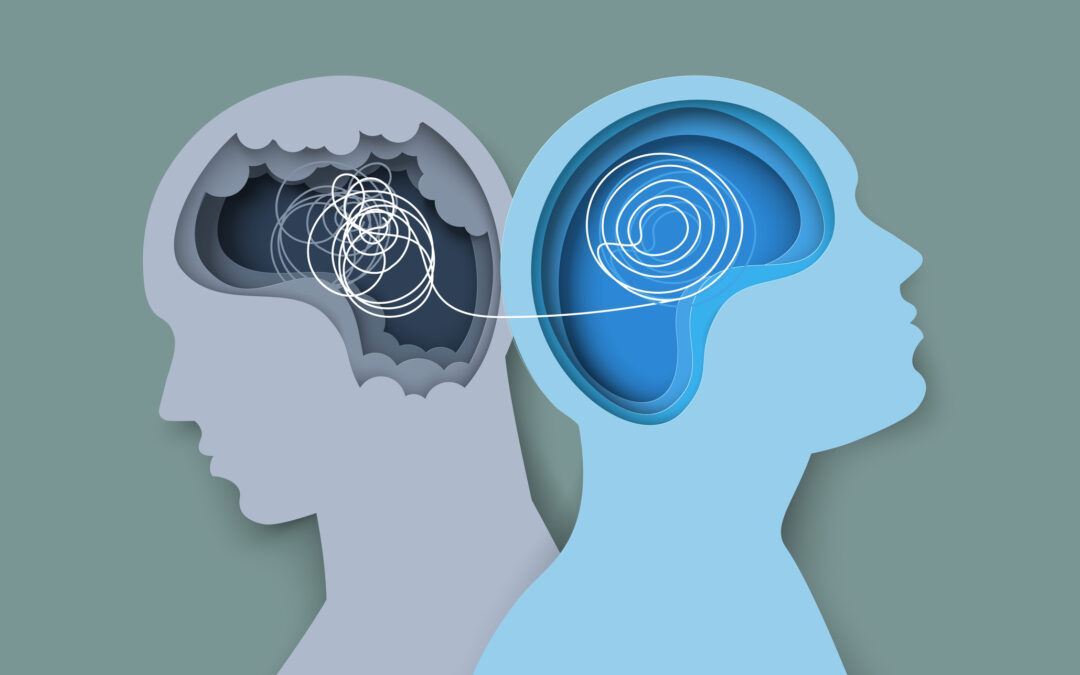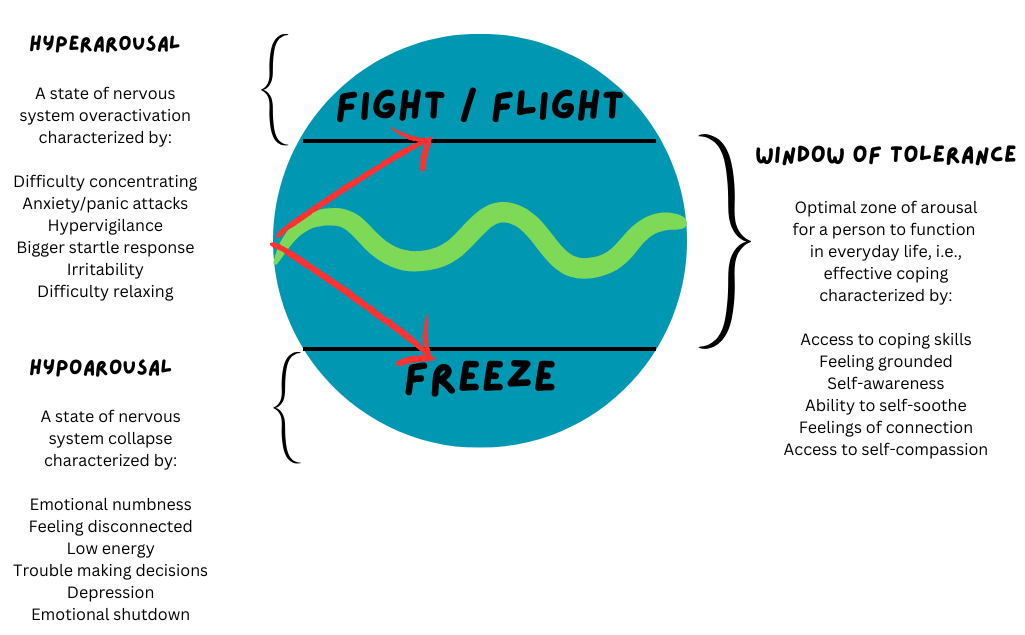
by Kayla Johnson | PTSD, Trauma, Trauma / PTSD
Navigating Trauma with Compassion
Finding Safety in Vulnerability
So much of the safety that is integral in therapy, especially for those of us with trauma histories, lives in the complex balance of security in the present moment and entering into vulnerability (painful emotion). Knowing this, it’s important to develop coping and grounding skills for withstanding the pain. At times, skill development feels frustrating (I know I have, on a number of occasions, balked at having to develop skills to cope with pain I did not ask for).
Strengthening Coping Strategies
Widening the Window of Tolerance
The more adept we become at coping with distress, the more we strengthen our ability to experience the here-and-now sense of safety in therapy as we face our pain.
When your therapist helps you ground, develop coping skills, notice the present moment, etc., they are helping you widen what we call the ‘Window of Tolerance.’ Maximum therapeutic benefit in an appointment with your counselor (or in coping outside session) happens when you are able to maintain awareness of the both/and of pain and safety.
Everyday Examples of Staying Within the Window
Remaining inside your window of tolerance doesn’t mean you don’t experience emotions. It means we minimize the distress that occurs when a painful emotion is present. Essentially, existing within that window means you can experience sadness, fear, or anger without triggering a survival (fight/flight/freeze) response. If you have ever become frustrated with a distracted driver while maintaining your ability to focus on the road, become upset with a partner and took space away to process emotions before resolving conflict, or made a mistake on a project and were able to reframe negative thoughts about yourself – You have remained within your window.
Becoming a Harbor of Safety
Progress in therapy does not mean something isn’t sad or scary over time. It means you become your own harbor of safety and remain compassionate and present with yourself as you heal. Safety is not always necessarily the absence of danger; safety is your ability to connect with yourself, your support system, or your coping skills when danger is present.
The Balance of Safety and Vulnerability in Therapy
In therapy, especially for those with trauma histories, safety is a delicate balance between feeling secure in the present moment and being open to vulnerability. This balance is crucial for healing and growth.
Developing Coping and Grounding Skills
Developing coping and grounding skills is essential for managing painful emotions. Although it can be frustrating to build these skills, they are vital for maintaining a sense of safety and stability during therapy.
Expanding the Window of Tolerance
When your therapist helps you ground yourself, develop coping skills, and stay present, they are helping you expand your Window of Tolerance. This allows you to experience emotions without triggering a survival response, enabling you to process and heal more effectively.

by Kayla Johnson | PTSD, Trauma, Trauma / PTSD
sistent across human history has been the importance of community. Safety in numbers against a predator, the sharing of resources, or simply holding space for one another are all integral to our survival. Yet, largely, our individualistic culture places emphasis on autonomy and independence. Self-care is a term used often within the context of therapy and trauma healing – and self-care is a necessary step – but often we are encouraged to lean into individual healing practices when what we need is to be reminded that we belong in the world around us.
Oftentimes we walk away from a traumatic experience with more barriers to accessing ourselves than ever before. We learn to mistrust ourselves and/or those around us; shame and guilt become the forefront of our self-talk; our emotions feel too dangerous to foray into. It is confusing to be told to access self for care when, commonly, self is difficult to find internally. Research tells us that connection to others leads to positive outcomes for trauma survivors (Goodman, Dutton, Vankos, & Weinfurt, 2005), and it tells us that even brief interactions with the world around (waving hello, for example) us are reliable mood-boosters (Santos, 2023).
So what does community care look like, and how can we engage in this type of inter-dependence on one another?
Community care at the micro level:
- Saying hello to a neighbor
- Meal prepping/cooking with a loved one
- Texting a friend
- Carpooling with a friend or colleague
- Checking in with your loved ones
Community care at the macro level:
- Participating in a community garden
- Community clothing swaps
- Group therapy spaces for processing and healing
- Volunteering for a cause you care about
- Community book clubs
- Participating in social activism
A reminder, too, that community care works when you receive care alongside providing it. Trauma recovery makes it difficult to remember that you, as much as your neighbor, are part of this community. Not every type of community care will be a fit for you, and that’s okay. Wherever you land, you are not alone. Healing takes place in the company of those who see and are seen by you.

by Ericka Martin | Anxiety, Apps, Depression, Featured, Insomnia, PTSD
Modern technology can be an amazing supplement to professional counseling. Check out these 12 Apps that come recommended for recovery from depression, eating disorders, PTSD, insomnia, and anxiety.
(more…)

by Ericka | PTSD, Trauma
Over the past several years, there have been numerous traumatic events making news all across the country. From incidents of mass violence to devastating natural disasters, hundreds of thousands of Americans have experienced or witnessed a disastrous or life-threatening event. In addition to tragedies such as these, anyone who has experienced a shocking or dangerous incident (such as a car accident, a robbery, an act of violence, or sexual abuse) is at risk of developing Post Traumatic Stress Disorder (PTSD).
PTSD is a serious mental disorder that requires medical treatment. PTSD can have devastating effects on every aspect of a person’s life, from their marriage and family, to their friendships and career. If you’re concerned that a loved one may be suffering from PTSD, here are some signs to look out for.
Reliving the Trauma
Someone with PTSD have repeated, involuntary re-experiences of the event or intrusive thoughts about it. They may experience bad dreams or flashbacks. They’re also vulnerable to certain triggers that remind them of what happened, such as sounds or smells.
Angry Outbursts
Someone silently suffering from trauma may be prone to anger, agitation, or sadness. Feeling irritable, the sufferer may be prone to outbursts of anger that they can’t control. If you’ve noticed your loved one frequently losing control and lashing out in anger, this is a sign that they’re suffering emotionally and require treatment.
Withdrawal
People suffering from PTSD will avoid people and situations that are reminders of the situation. As the victim continues to isolate themselves, how their friends and family react to their withdrawal will likely further isolate them, causing additional emotional distress.
Numbing
It’s not uncommon for people with PTSD to self-medicate, seeking an escape from high levels of stress and difficult emotions. Some may keep themselves so busy they don’t have time to think or feel. Others might numb with food or sleep. Others turn to drugs or alcohol, which leads to risk of addiction. The painful trademark of substance abuse is the growing need for more of the drug to produce the same high. If left untreated, as substance abuse grows, the abuse will turn to addiction and eventually dependence. This can have devastating effects on every facet of a person’s life.
If you’re concerned that a loved one is experiencing symptoms of trauma, the most important think you can do is encourage them to seek professional diagnosis and treatment as soon as possible. Assure them of your support throughout the process.
For additional guidance and recommendations from a licensed professional, call our office today. We have licensed counselors available to help with trauma processing, including counselors that use evidenced-based approaches such as EMDR and Cognitive-Behavioral Therapy for Trauma.

by Ericka | PTSD, Sexual Abuse / Trauma, Trauma
On an almost daily basis we hear stories of female sexual harassment and abuse in the media. Sadly, male sexual abuse is fairly common, but the issue is under-reported by the media and society in general.
One US-based study found that 1 in 6 boys experience some form of sexual abuse by the age of 18. Other research suggests the ratio may be as high as 1 in 4.
Why is this conduct not reported more often?
To start, most men are embarrassed to be the victim of sexual abuse, particularly when it is perpetrated by other men. In our culture, men are supposed to be invulnerable and not feel emotional pain. In other words, guys are supposed to be the strong, silent type. It simply goes against the silent rules of being a man to acknowledge trauma and admit that you are suffering.
As a result, male victims of sexual abuse shove their feelings down and deny what happened. This repression of experience and emotion can and often does lead to isolation, anger, sadness, shame, guilt, and fear. Post-traumatic Stress Disorder (PTSD), major depression, anxiety, and substance abuse are also common among victims of male sexual abuse.
It’s important to get help.
If you are the victim of sexual abuse, understand that you are far from alone. As the topic becomes more mainstream, there is less judgement by those who don’t understand how a man could be victimized in such a way. Education regarding male sexual abuse and demystifying misconceptions surrounding rape is essential to help male survivors heal and speak out.
While more needs to be done to bring this subject to mass awareness, it’s important that individual victims seek support. A therapist will be able to help you deal with your complex emotions and offer strategies to move through and past feelings of depression and anxiety. In time, healing can and does occur.
We have trauma counseling specialists available.
If you or someone you know is a male victim of sexual abuse and would like to discuss treatment options, please get in touch. A counselor from our team would be more than happy to help. We have two counselors available with an EMDR specialty and one who is a certified IATP Clinical Trauma Professional.

















